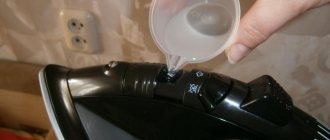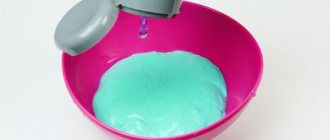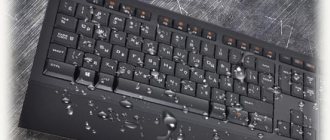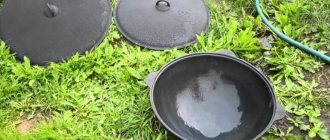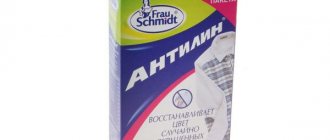Every housewife at least once in her life has encountered a situation where food burned in her favorite enamel saucepan. With great pity they examine the charred walls, which also emit a terrible burning smell that spreads throughout the apartment. What to do in such a case? How to quickly remove foul-smelling burnt marks from an enamel pan?
To ensure that a burnt enamel pan does not become the reason for a lost day off, it is advisable to learn all the secrets of getting rid of soot in advance.
Features of enamel pans
The history of enamel cookware began in ancient times, when the ancient Greeks first came up with the idea of applying enamel to the surface of kitchen utensils. But such vessels were not used for cooking, and they served as a kind of decoration.
Often carbon deposits are cumulative.
Already today, such dishes have become widespread due to their unique properties. What, essentially, is such a pan? This is a product made of steel or cast iron coated with a layer of enamel. It is an excellent food protection against metal. It's much safer to cook in it. But if something happens, it will be more difficult to wash such dishes, and the layer of glass enamel may crack due to sudden temperature changes.
Household chemicals
Today you can see a large number of cleaning products on the shelves, but often they do not justify their cost. It is better to use cheap but effective analogues from a domestic manufacturer, since the composition of all is almost the same. Ammonia and alkali, used as the main components, have a bad effect on the enamel. Therefore, the housewife must ensure that there is a minimum amount of them in the composition.
To remove persistent thin deposits from glass and enamel surfaces, you can use the cheap Sanitol product. Within 15-20 minutes after spraying, you can even wash the outer part of the pan.
Sometimes simply soaking the dishes in warm water will be enough to clean them.
Types of stains from burnt pans
Food in general leaves marks on the sides and bottom of the pan, but some stains are particularly stubborn. One of the most unpleasant is burnt marks, which are very difficult to remove. It usually occurs due to forgetfulness. Most often the porridge burns. Depending on the type (buckwheat, rice, pearl barley), the difficulty of cleaning varies: everyone knows that milk porridges burn more strongly. Milk deposits are also difficult to remove, but the sooner you start the procedure, the faster it will go away. So, the most persistent stains arise from burning:
- milk;
- jam;
- various types of cereals;
- vegetables (beets are especially difficult to remove).
If the enamel pan is not washed well, the remaining fat will burn to the outer part of the sides over time.
You can also distinguish carbon deposits not only by their origin, but also by the strength with which it adheres to the dishes.
When heavily soiled, burnt food remains at the bottom of the pan in the form of a black layer of several millimeters, sometimes more. Here you need to put a lot of effort into cleaning. The average degree of soot has a thin layer that can be easily removed if you get down to business right away. In mild cases, individual burnt spots are scattered across the surface and can be cleaned with a regular sponge and hot water.
The inside burns as a result of cooking.
Separately, it is worth mentioning stainless steel pans. Many people use them to cook a wide variety of foods. It is believed that nothing will burn in it, and if trouble does happen, everything can be easily cleaned with a metal sponge and caustic chemicals. A stainless steel pan is very resistant, and therefore you can easily rub it with sponges, use various detergents, but you still shouldn’t abuse them, because it’s not always possible to wash everything off clean, and some of the chemicals can get into the food.
If you don’t have time to buy cereal or milk, it will be very difficult to wash the dishes.
Features of cleaning individual products
Each disease has its own treatment method. The same principle is used when washing your favorite dishes. To quickly solve the problem, you need to know how to deal with standard cases: burnt milk, cereal, fruit, meat, etc. Therefore, it is worth highlighting the most effective and quick methods that will return the previous appearance to a frying pan, saucepan, and even a baking sheet.
For an effective method of cleaning dishes, you can use Coca Cola.
Liquids
Cooking milk porridge or simply heating it can cause a dark crust to form. You can get rid of it by simply soaking it in warm water without adding any products. However, if the soot is old, then solving the problem is tens of times more difficult. Coca-Cola can be used as an effective method. The drink will preserve the appearance of the enamel cookware inside and completely remove carbon deposits from the bottom. Soaking time – from 1.5 to 3 hours.
Cereals
How to clean the burnt bottom of an enamel pan after cooking cereal is the most popular question on the Internet. To solve the problem you will need medications. Activated carbon is recommended as an alternative cleaning agent. The tablets must be crushed and filled with a small amount of warm water. The mixture coats the burnt inside of the pan. After 40-60 minutes, you can start scrubbing the burnt off with the soft side of the sponge.
Activated carbon will help clean the burnt bottom of dishes.
Vegetables or fruits
Products of plant origin often leave an unpleasant residue that has a specific odor. You cannot get rid of it with simple soda and boiling. For a quick solution, use coffee grounds. If you don’t have it at hand, you can contact any barista on the way home. Coffee grounds will remove odor and polish the surface. However, before using it, it is advisable to soak the dishes in warm water for 20-30 minutes.
Pasta
Pasta that is burnt on the bottom of a pot or pan can be removed quickly and efficiently using ammonia. The product dissolves burnt dough within 10 minutes. However, an odor may remain.
The second option is to use vinegar. Does not leave a specific odor, but the soaking period is 30-50 minutes.
If time allows, you can use the old and reliable method - pour boiling water over the dishes in the morning and go about your business. In the evening, burnt pasta can be easily washed off with water.
You can use coffee grounds to polish the surface of your cookware.
Meat
Any meat leaves a fatty and heavy soot. It is especially difficult to get rid of it if the problem is neglected and has not been solved for years. However, any dishes can be washed if you know the right product. Experts recommend using a solution from “Belizna” as the most effective. The chemical will help clean even the most neglected baking sheet, completely ridding it of bacteria and dirt. For this you will need:
- A few spoons of “Whiteness” – 20-30 ml;
- Soda - 3 tbsp. spoons;
- Hot water – 2-3 l;
- Latex gloves.
The solution is poured for 2-3 hours. To clean the outer surface, apply soda diluted with “White” to the sides. After the procedure, use the rough side of the sponge for cleaning.
Baking soda has cleaning and antibacterial properties.
What to do if a pan is burnt
The key to success in this case is efficiency. The faster the pan is washed, the easier it will be, firstly, to deal with the stuck carbon deposits, and secondly, the less money will be required for this.
In general, basic advice.
- Act without delay.
- Under no circumstances should you pour cold water into the pan: a temperature difference will cause damage to the enamel, or even chip it. It is better to fill the cooled dishes with slightly hot water with the addition of soda.
- You need to use gentle products: no steel wool or toxic products.
The more a pan is used with carbon deposits, the less likely it is to be washed in the future.
Useful tips
To maintain the attractive appearance of enamel cookware, you must follow some rules.
- When purchasing a new enamel-coated pan or bowl, harden it. This will make the enamel layer more resistant to mechanical stress, which will somewhat extend its service life. The process is quite simple: you need to pour water into a new container and bring it to a boil, then let it cool without pouring out the water.
- Do not use cleaning products containing abrasive materials, metal sponges, or especially brushes. They leave microscopic scratches on the surface, which promotes burning later, complicates cleaning and simply damages the enamel.
- Do not leave pots unwashed, or rather, do not allow food residues to dry on the walls of the dishes. This makes it difficult to clean and encourages the use of harsh products, which ultimately shortens its service life. If you don’t have time to wash it right away, then at least soak the dishes.
- Do not use enamel containers as a frying pan, that is, do not fry potatoes in them, do not sauté onions, or do other similar things.
- Do not boil milk or prepare dairy dishes that involve boiling.
- Make sure that the dishes are clean not only from the inside. The outer surface, especially the bottom, can also accumulate carbon deposits. Various types of contaminants stuck to the container from below burn when it is heated on gas or in an electric oven and require subsequent labor-intensive cleaning.
- Protect the dishes from destructive mechanical influences: do not drop them or hit them with metal objects.
- During the cooking process, use wooden utensils for stirring, this will extend the life of the enamel and cookware in general.
- Avoid critical temperature changes. For example, you don’t need to pour boiling water into a cold pan.
Advice to housewives on how to protect light enamel - video:
Traditional methods for cleaning a heavily burned pan from scorching
These methods are very popular for several reasons.
- The products used will be available in sufficient quantities for almost everyone.
- Harmlessness and safety of cleaning.
- An abundance of cleaning options, the ability to combine them together in any order.
Soot has a negative impact on human health.
How to remove salt burns
Table salt is an excellent absorbent, so its use is quite logical.
If there is only a little soot, just sprinkle it in a thick layer and pour in a little water. After two hours of soaking, you can wash with a sponge.
Salt is a great helper for every housewife.
If the pollution is serious, then the actions are different. They also take water into the pan, add one hundred to two hundred grams of salt, and begin to boil. After half an hour, the pan can be removed from the heat and left to cool. Afterwards they wash with a sponge and gel. If the burning remains, then the manipulation is repeated.
Cleaning with vinegar
Acids also do a good job of removing carbon deposits, but they must be used carefully. Usually a little vinegar is poured into a bowl and left for a couple of hours. Some people recommend heating the vinegar. Citric acid is often used instead.
A useful remedy for combating unpleasant and musty odors.
How to Remove Burnt Stuff with Baking Soda
Soda remains the most popular and effective remedy. It is good for cleaning both light dirt and old stains. Its effectiveness is due to its ability to react with other substances (for example, acids).
If there is a slight burn, take a little soda and scrub the walls and bottom of the pan like a regular detergent. However, what to do if the stains just don’t want to go away? Then it makes sense to combine sodium carbonate and vinegar.
One of the most accessible ways to clean a burnt enamel pan is to use soda.
The bottom is covered with a small layer of soda, to which a few tablespoons of vinegar are added. The mixture is placed on the fire and heated until the smoke begins to lag behind. You can simply leave the solution overnight, then there is no need to heat it.
The combination of soda + salt also gives good results. In a separate container, mix the two ingredients in equal proportions to form a paste, which is applied to dirty areas.
How to clean a burnt bottom with laundry soap
Many people have pieces of dark yellow soap, the so-called, stored at home. economic. Despite the unpleasant smell, it copes well with burning of varying degrees of complexity.
The soap is ground and placed in boiling water in a pot or pan.
The first way is to grate the block on a coarse grater and throw the shavings into warm water. Place on the stove, bring to a boil. After the procedure, we check the ease of removing carbon deposits - if it just comes off under the sponge, then everything went well.
Using activated carbon
An effective and cheap remedy is activated carbon in tablets, which must be thoroughly crushed, mixed with warm water and applied in a thin layer. Afterwards the mass is washed off. This method is suitable for small pots with light dirt.
Activated carbon will help clean the burnt bottom of dishes.
Cleaning the inside of a burnt pot with coffee grounds
Coffee grounds can polish the surface of the dishes well and remove the greasy layer. Small particles penetrate the burnt area, cleaning it off. The coffee aroma eliminates the unpleasant burnt smell. The thicket is effective only when the problem is not advanced.
You can use coffee grounds to polish the surface of your cookware.
Using carbonated drinks to clean a burnt pan
The excellent cleansing properties of carbonated drinks have been known for a long time. The phosphoric acid they contain corrodes any stain, even stubborn stains. At the same time, it does not leave stains and has a pleasant smell that can cover up the fumes.
For an effective method of cleaning dishes, you can use Coca Cola.
Application is simple: pour a bottle of Coke or Pepsi into the pan and leave overnight. To enhance the effect, it can be boiled, which only promotes whitening. It is not recommended to use tarragon - it is painted very often.
Salt and marinate the saucepan
The difficulty is that if it is the enamel pan that is burnt, you cannot use abrasive cleaning powders. As a result, the enamel will quickly begin to crack and chip, and the dishes will become unusable. This means that we will have to go a different way. The first available remedies that are probably in every kitchen and that are worth trying are salt and vinegar.
- Cleaning carbon deposits with salt. First you need to thickly sprinkle salt on what is burnt, and then pour water on it. Let the pan remain in this state for at least half an hour, but preferably two or three. Now, using hot water and the hard side of the dish sponge, you can begin to scrub the bottom of the dishes. Not everything went away. Then boiling will help. Pour a glass of water into the pan (or more if it is large) and add two tablespoons of kitchen salt. All that remains is to boil the utensils over low heat for an hour. The remaining carbon deposits should come off easily after this procedure.
- Using vinegar. In this case, everything is even simpler. You just need to pour table vinegar over the blackened bottom, cover the dish with a lid and leave for three hours. During this time, food residues that have firmly adhered to the enamel will dissolve and can be easily removed using a regular kitchen sponge and dishwashing liquid.
A little advice: both salt and vinegar dry out and corrode the skin of your hands. Therefore, before starting work, it is better to wear rubber household gloves.
How to clean an enamel pot with household chemicals
To quickly and effectively remove fumes from dishes, chemical detergents are best suited. Specialized aggressive substances in their composition are capable of dissolving fat, soot, and even old carbon deposits.
The presence of ammonia and alkali in household chemicals has a bad effect on enamel cookware.
The most commonly used substance, popular in household chemical stores, is white. The damaged vessel is filled with cold water, a tablespoon of white is added to it, and left to soak overnight. After this, the mixture is poured out. Pour clean water again and set to boil. Then the water is drained and the boiling procedure is repeated until the dirt disappears.
As a result, the dishes are thoroughly rinsed with running water. There should be no traces of whiteness left anywhere, because if it enters the body it can lead to serious health problems.
Every owner should know how to clean a burnt enamel pan without harming it.
Second method: using washing powder. Add a steep solution of powder in a basin and place a pan in it. After soaking, rub off the burnt areas and rinse under the tap for several minutes so that all the powder is washed off.
The third method of using household chemicals is a combination of silicate glue and soda. Everything is more complicated here, and to carry out the procedure, you need to make some preparations.
- Find a large pan so that the dirty one can fit into it.
- Water is poured into it.
- Pour in half a pack of soda and silicate glue (one bottle).
- Then the solution is put on fire and stirred, bringing it to the consistency of a medium-thick paste.
Even the use of familiar chemicals can lead to complete damage to your favorite dishes.
In order to clean the pan, it is immersed in this solution and kept there for fifteen minutes. Then take it out and wash it. The remaining carbon deposits are cleaned off. The method is suitable for removing particularly strong contaminants, and the duration of boiling largely depends on their degree. The dirtier it is, the longer the dishes take to boil.
How to remove with special compounds?
If you don’t want to use homemade recipes, you can purchase special formulations designed to remove carbon deposits from dishes. Top 3 effective remedies:
Non-stick Floreal
The composition is available in the form of a spray, suitable for treating metal surfaces, and effectively copes with old grease and smoke. Price – 250 rubles. Read reviews here.
Bright
The cleaner for enameled gas and electric stoves and surfaces is available in the form of a liquid, which is bottled in a convenient bottle equipped with a dispenser. The composition acts quickly, it is applied to the contaminated area, left for 2 minutes and washed off . Price – 160 rubles.
Dr. Beckmann
The release form of the detergent is gel. It contains surfactants, xanthan gum and sodium hydroxide. The product does not harm enameled surfaces and allows you to get rid of carbon deposits and old fat. Price – 345 rubles. Read reviews here and here.
When purchasing, you need to pay attention to the following points:
- Compound. The enamel is resistant to salts and acids, it can be washed with a surfactant-based product, soda and soap.
- Scope of application . The product must be intended for the care of enamel surfaces.
- Release form . You should not purchase powder formulations, as they contain abrasive particles. Preference is given to gels and liquids.
- Price. The more natural and high-quality the composition, the higher the cost of the final product.
Features of using cleaning products:
- It is most convenient to apply the product using a sprayer;
- The exposure time of the cleaning agent should not be increased independently - violation of the manufacturer’s instructions can lead to damage to the enamel;
- When working with household chemicals, you need to take care of your safety; to do this, protect the skin of your hands with gloves;
- If the substance has a strong odor, then the cleaning process should be carried out in a well-ventilated area.
Detergents should be stored closed, out of the reach of children.
The nuances of cleaning a badly burnt pan
A very burnt pan can cause a lot of problems, because it will take more time and effort to clean it up. But don't despair. The use of combined remedies and persistence will help solve this problem.
Enamel is a fragile coating that can be damaged with a simple iron float.
- Soap and ammonia together will quickly clean any burnt surface. Soap shavings are mixed with a tablespoon of alcohol and boiled.
- Salt, glue and soap. Ammonia and glue are poured into the soap foam. Place a pan in a container and keep it in boiling water.
How else can you clean carbon deposits?
In most cases, you can clean a burnt enamel basin or pan using the methods described above. Some of them have been time-tested and have proven themselves well through many years of experience. Others, more modern, are no less effective and therefore also popular. But there are a number of other methods that are distinguished either by their environmental friendliness or by their unconventional approach to the cleaning process. They will be discussed further.
- Apple peel. If enamel cookware is burnt, this is the most environmentally friendly way to remove the consequences. To successfully implement it, you just need to boil the peels of sour apples in a small amount of water. If you don't mind apples, you can boil them too.
- Milk serum. An equally environmentally friendly method, which involves boiling the whey in an affected container. After which it is enough to wash it in the standard way.
- Freezing. An option for owners of freezers and residents of regions with a suitable climate. You can free the pan from burning by exposure to low temperatures (-30 C˚). To do this, place it in the freezer for a short time, then let it warm up at room temperature. To be sure, the cycle can be repeated several times.
How not to clean a pot from burning
No matter how strong the desire is to use a hard brush or, even worse, a fork or spoon, you need to refrain. Enamel is very sensitive to mechanical stress, and such manipulations can cause cracks and chips. You can’t use the pan after this.
A good habit - washing dishes immediately after eating will have a positive effect on the condition of your household utensils.
You should also not use abrasive powders, because their solid particles scratch the surface of the pan and also penetrate micropores, which creates a health hazard - the substance is not so easy to wash off, and it is guaranteed to get into food.
Enameled dishes are afraid of temperature differences. You cannot pour ice water into a hot pan, and vice versa.
It is best to wash with warm liquid, thirty-five degrees.
If the housewife often forgets about the porridge being cooked on the stove, then it is more convenient for her to use dishes made of another material, which is much easier to clean in case of burning. A good option would be stainless steel, which is completely undemanding in terms of cleaning methods.
Before you clean the inside of a burnt enamel pan, it’s worth dealing with the outside, because it also requires careful treatment, and it’s always easier to wash the outside first than the inside.
To prevent contamination, it is advisable to periodically inspect all household utensils.
How to return enamel whiteness
White cookware enamel needs to be lightened after removing the burnt crust. To clean the surface from yellowness, the following compositions are prepared:
- add ¼ tsp to a strong solution of salt or soda (250 g per 100 ml of water). vinegar essence and soak the dishes overnight;
- citric acid is mixed with water in a ratio of 1:14 (for example, 1 tablespoon of lemon per 14 tablespoons of water, which is equal to 250 ml);
- vinegar essence is diluted with water in a ratio of 1:7;
- The bottom of the dish is evenly filled with peels from sour apples.
The product (except apple peel) is left in the container for 8-12 hours, and then boiled over low heat for 20 minutes.
You can wash the pan from dark deposits inside with a slurry of mustard powder, whey or lemon juice. It is better not to experiment with bleaching chemicals.
Helpful precautions when cleaning an enamel pan
- To protect the skin of your hands from the harmful effects of chemicals, you need to wear gloves. Even salt can cause irritation, so it's better to be safe.
- When making solutions and boiling water, you should not bend over the pan or grab it with your bare hands. It's safer to use an oven mitt.
- Before use, carefully read the instructions for detergents.
Timely care will help keep the entire set looking good for longer.
Enamel cleaning methods
At home, you can wash off dirt from an enamel pan and clean the burnt bottom using both chemicals and traditional methods. The second option is completely safe for both the pan itself and people.
Basic cleaning rules
When cleaning burnt food, avoid sudden temperature changes (hot → cold). Do not use strong abrasives or brushes. Try not to rub dishes with powders. Enamel is a sensitive coating.
Removing fat and plaque
When boiling water or cooking vegetables (especially beets), scale often appears in the pan (it becomes covered with a white coating). After cooking fatty foods, fat may burn on meat.
Citric acid can be used to remove scale and grease from a pan. It perfectly cleans the enamel without damaging it.
What to do:
- Pour a packet of acid into the pan and pour in water.
- Boil for 30 minutes.
- Pour out the liquid.
- Remove any remaining dirt with a sponge.
- Rinse.
Removing carbon deposits
Don't despair if your enamel pan burns. The products available in the kitchen will help you win the fight against carbon deposits. For example, the following products are good for cleaning a pan from burning:
- soda;
- coffee;
- Activated carbon;
- vinegar;
- tomato, lemon juice;
- salt;
- laundry soap.
All of these substances will clean the burnt in the saucepan well without damaging the enamel. When cleaning, do not rub the pan, but soak it!
How to properly care for enamel cookware
Any utensils require careful treatment, and enameled ones even more so. We must always remember the features of this material. When washing by hand, use soft sponges. Washing in the dishwasher is not a good idea, as this procedure often darkens the enamel.
Following simple rules will help you avoid the question of how to clean a burnt enameled pan in 90% of cases.
Before first use, it is recommended to calcinate it: bring water to a boil and cool. After this, the pan will be stronger.
To avoid food burning, it is better to cook only compotes, soups, eggs in an enamel container, that is, things that will not create a layer of burning. For those who decide to cook other dishes, you need to carefully monitor the cooking process, and at the slightest suspicion of overheating, reduce the heat or remove the pan from the stove.
After familiarizing yourself with all the methods for cleaning pots, you can choose the one that suits your dishes.
Enameled cookware is a constant companion in the kitchen, without which it is impossible to imagine cooking. But in order for the dishes to serve as long as possible, they should be carefully looked after, following the rules and remembering the differences between enameled products.
You should not ignore the advice on using enamel.
Removing yellow plaque - verified by the editors
Fill an enamel plate with an aqueous solution of citric acid for 8 hours. The proportions were taken as 1:14, or 1 tbsp. l. lemons per 280 ml of water (based on the calculation that 1 tbsp contains 18-20 ml of liquid).
Then they boiled it over low heat for about 20 minutes. During the process, it even seemed as if the stains were disappearing right before our eyes. But the result was only 30-40% cleansing. Perhaps it was necessary to rub with force when washing, but the method with mustard paste was tested.
We stood it for a couple of hours, the result was zero. Moreover, upon subsequent boiling of clean water, it had to be drained because it turned yellow.
For the sake of the experiment, since citric acid helps, it was decided to increase its concentration in the proportion of 3.5 tbsp. l. for the same 280 ml of water. The solution was kept for 8 hours and boiled.
We see the result in the photo. Along with the dark coating, the glossy layer of enamel was also removed.
Conclusion: the method with citric acid works, but it may have to be repeated. And when increasing the number of components, proportions must be observed. Glossy enamel is not afraid of acids, but only in a certain dosage.
We recommend reading: How to clean a stainless steel sink.
Cleaners
The modern market offers many products for removing burnt food, scale, and yellowness. The most famous substances:
- Schumann;
- Cif;
- Cillit Bang et al.
Important! The main disadvantage of most chemicals is toxicity. The composition contains acids and surface-active components that adversely affect health.
Household chemicals
When using detergents, do not forget to rinse the enamel pan thoroughly! The choice of a suitable tool depends on financial capabilities. Application is practically the same: slightly heat the pan, spread the product over the entire surface, leave for 30 minutes. Then wash with a soft sponge.
Traditional methods
Using home remedies, you can also clean the inside of an enamel pan from blackness, wipe off soot or dark deposits that appear during use.
Salt
One of the long-known methods of how to wash an enamel pan is cleaning with salt. Salt cleans burnt milk well and whitens yellowed dishes:
- If food is burnt, immediately remove the enamel pan from the stove and leave to cool.
- Pour in water to cover all dirt.
- Add salt.
- Leave for 1 hour.
- Try to remove as much carbon deposits as possible with a wooden or plastic scraper. Do not use metal scrapers as they may damage the surface.
- If you cannot remove other contaminants, add water and salt again and boil.
- Leave to soak for about 12 hours.
- Then boil again and, after cooling, try again using a plastic or wooden scraper to remove burnt food residues.
- After cleaning, wash the dishes.
